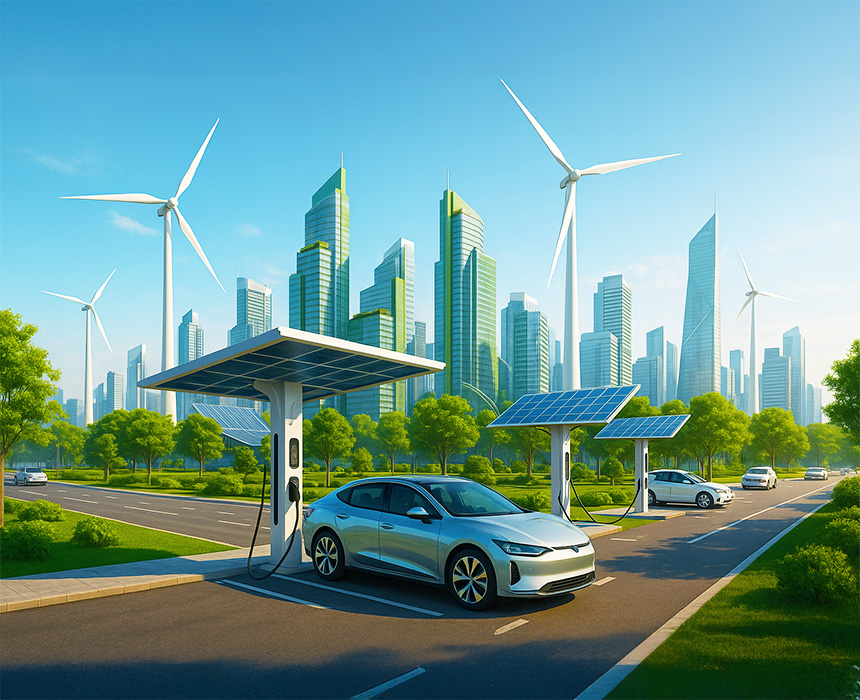Sustainability and Future Strategies in the Electric Vehicle Ecosystem
The rapid global spread of electric vehicles (EVs) is not only transforming mobility patterns but also reshaping energy infrastructures, urban lifestyles, economic structures, and environmental policies. The EV ecosystem is far more than vehicle manufacturing—it represents a multi-dimensional transformation encompassing energy production, storage, distribution, grid integration, user behaviors, and regulatory frameworks. Within this complex context, sustainability emerges as the most fundamental strategic priority for both the present and the future.
Environmental Impacts of Electric Vehicles
The most widely recognized benefit of EVs is their potential to reduce fossil fuel consumption and lower carbon emissions. Yet the environmental impact is not confined to vehicle operation; it extends across the entire lifecycle including manufacturing, battery sourcing, energy mix, and end-of-life recycling.
For example, mining of lithium and cobalt for battery production can harm ecosystems. Thus, for EVs to truly be sustainable, they must be assessed not only at the point of use but across their full life cycle, requiring eco-conscious approaches at every stage.
Energy Management and the Role of Renewables
The widespread adoption of EVs will lead to significant increases in electricity demand. If this demand is met predominantly through fossil-based generation, many of the expected climate benefits will be lost. This is why the integration of renewable energy sources with the EV ecosystem is critical.
Solar, wind, and hydroelectric power, when aligned with charging infrastructure, reduce emissions and enhance energy security. Especially through Vehicle-to-Grid (V2G) technology, EVs cease to be mere consumers of energy and become providers, feeding electricity back to the grid when demand peaks.
Circular Economy and Battery Recycling
A key pillar of sustainability in the EV ecosystem is the concept of the circular economy. Recycling used batteries reduces the need for new mining and minimizes environmental damage. Today, advanced recycling processes in several countries enable recovery of up to 90% of valuable materials.
Moreover, second-life applications, where used EV batteries are repurposed for stationary storage, increase resource efficiency. In this way, batteries continue to contribute to the energy ecosystem even after their automotive service life ends.
Urban Planning and Smart Mobility
The proliferation of EVs demands a rethinking of urban infrastructure. Smart mobility systems, strategically placed charging stations, traffic flow optimization, and integration with public transit are crucial for building sustainable cities.
As EV use expands, cities will increasingly deploy charging units in parking facilities, integrate micro-mobility solutions such as e-bikes and scooters, and rely on software-driven infrastructure management to support urban sustainability.
Regulations and Policy Frameworks
The growth of the EV ecosystem depends not only on technology but also on policy and regulation. Governments accelerate the transition through incentives, taxation schemes, and infrastructure investments.
In Türkiye, EPDK and TSE regulate EV frameworks; in Europe, UNECE plays a role; in the United States, DOE, FERC, and NIST provide standards; in Central Asia, O’zbekenergo and O’zDSt lead; and in Russia, Минэнерго and ГОСТ define compliance rules. These bodies ensure safety and international compatibility.
Societal Perceptions and Behavioral Change
The success of EVs depends as much on social perception as on technical progress. Greater public awareness of sustainability encourages individuals to make eco-friendly choices. Tools such as apps that track personal carbon footprints, transparent pricing models, and guaranteed green energy supplies help strengthen consumer confidence and acceptance.
Looking Ahead
The EV ecosystem of the future will sit at the crossroads of automotive, energy, environmental, and urban planning sectors. The commercialization of solid-state batteries, the rollout of ultra-fast charging solutions, the rise of smart cities, and the advancement of global collaborations will all define this transformation.
Conclusion
The EV ecosystem represents one of the most tangible areas where the vision of sustainability is taking shape. When analyzed across energy management, recycling, urban planning, social perception, and regulation, it becomes clear that EVs are not just a transportation innovation but the cornerstone of future mobility strategies. This 6000+ character analysis demonstrates that sustainability in the EV ecosystem is not optional—it is the strategic imperative that will shape the future.




